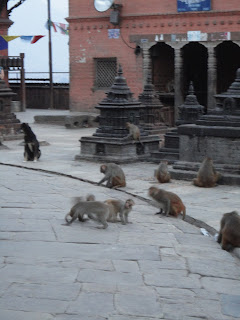Hi!
I thought I would write a bit about the Monkey Temple I visited a few days ago. Monkey Temple is known as Swayambhunath Stupa to the locals. Swayambhunath's worshippers include Hindus, Vajrayana Buddhists of northern Nepal and Tibet, and the Newari Buddhists. Each morning before dawn and even throughout the day, people climb the 365 steps that lead up the hill (mountain to foreigners) and begin a series of clockwise circles around the stupa (Newari Buddhists circle in the opposite, counterclockwise direction). The stupa is surrounded by prayer wheels which you spin in a clockwise motion as you walk around the stupa.
Interesting fact: I learnt that Nepali people don't consider the hills that surround the valley mountains...they are simply hills. to tourists, they are what you would consider mountains. What they consider mountains are the Himalayan mountain range.
On each of the four sides of the stupa there are a pair of big eyes. This stupa is very similar to the Bhoudhanath stupa I mentioned in a previous blog. These eyes are symbolic of God's all-seeing perspective. There is no nose between the eyes but rather a representation of the number one in the Nepali alphabet, signifying that the single way to enlightenment is through the Buddhist path.
I went with Nabin and Sandy right after work and it was the perfect time to go. Monkeys were climbing everywhere and there were hardly any visitors to the stupa. The monkeys are considered holy. I was told the monkeys hang out there because it is an escape from the city. We spent some time admiring the city view of Kathmandu from the Swayambhunath peak, and soaking in some clean and fresh air, which was a big contrast from the city. Getting to the top was entertaining because there seemed to be a lot of baby monkeys this time of year playing and the refreshing change of scenery was nice because it felt like we were in the middle of a tropical forest.
At top it was amazing to see the sun setting and kind of funny at the same time. We were laughing about the load shedding problem in the Kathmandu Valley because as the sun set, you could see which districts had power and which districts did not. The valley started to light up except for odd pockets of houses here and there. Taking a picture from an airplane would make for a very interesting picture. It is troubling to understand this problem considering Nepal is second largest country in water resources and hydropower potential. What brings Nepal to a load shedding problem is politics.
At the top, a man was feeding the stray dogs oatmeal. This was the first time I have seen anyone feed any stray dogs in Kathmandu. Apparently devoted people climb the steps every morning and evening to feed the monkeys and dogs. Most of the time, the dogs wait to eat out of opened garbage on the street....they are the bottom feeders.
There are new puppies in my neighborhood! I see them almost everyday :) Jesse said I should slingshot food to them from my patio. We are advised not to approach the animals in Kathmandu valley as a lot of them could have rabies and are diseased. My doctor here even made me get a preventative rabies shot but I thought this was a bit extreme. But I was thinking, even if I were to slingshot food off my balcony for the stray animals in my neighborhood, the animals would not be the only ones scavenging for it.
Unfortunately a lot of people in Kathmandu valley are extremely poor and homeless or poor and have very low standard living conditions. At night, plenty of people go through garbage piles in the dark looking for anything that is edible. It is very sad to see and hard to actually imagine living that way. I have been trying to research if Nepal has soup kitchens but I imagine it would be very difficult to run soup kitchens here with one of the poorest populations. What is amazing to see in Nepal is the amount of filtering the garbage goes through before actually being disposed. Firts people throw out their trash, then people on the stree go through the garbage, then the cows go through the garbage, then the dogs, go through the garbage, then the bugs....etc etc. Everything is used to its maximum benefit here despite the mounds of garbage you see in the main districts.
There are hundred of non-governmental organisations in Nepal and you can see success in all of them but there is still a ton of work to be done to bring Nepal out of poverty during their transition period. As a westerner though, it is very difficult to try and understand the problems of Nepal as I have not lived here for my entire life, lived through their history nor understand completely their way of life. It is very important to realise that developed countries do not always have the best solutions. There that famous corny saying "Give a man a fish; you have fed him for today. Teach a man to fish ; and you have fed him for a lifetime" but even that is very egotistical of westerners. That quotation is assuming we know the best fishing practices..or for the case of Nepal, we can easily assume we know the best poverty reduction strategies or what is best for Nepal but we in fact may not. Things here are so complicated its ridiculous. There is more than enough potential and with two major countries competing for interest in Nepal, its confussing to understand why Nepal has not used this to their advantage. Especially considering what I have already mentioned with regards to Nepal being the second largest country in water resources and hydropower potential.







No comments:
Post a Comment